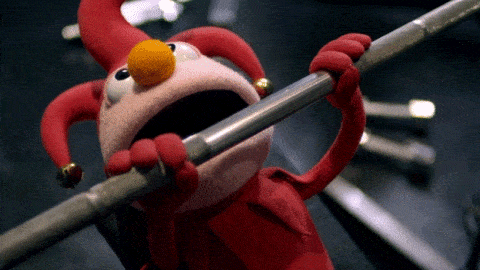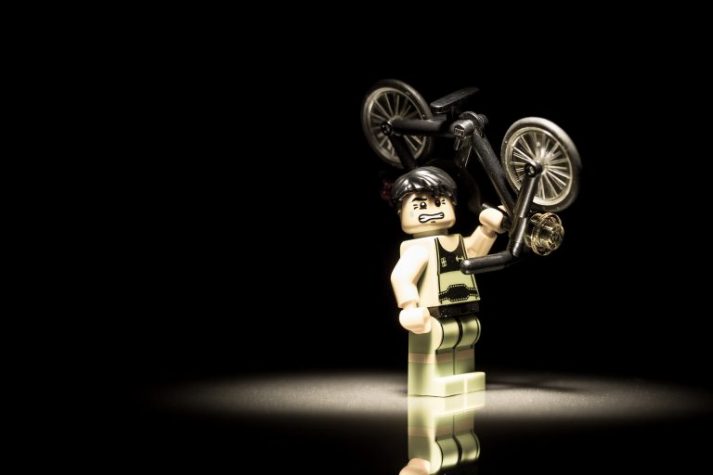How Many Sets and Reps Should I Do? (Building The Correct Workout Plan)

If you’ve ever asked yourself “Am I doing too little or too many reps and sets?” then this guide is for you.
This article is part of our Strength 101 series, and we’ll show you exactly how to determine the number of repetitions and sets for specific exercises, so you can build your own workout routine.
It sounds easy, but depending on your goals, the answer to “How many reps and sets should I do?” can vary greatly.

We work hand-in-hand with our Online Coaching Clients to create the correct workout program that suits their goals, needs, and available equipment
In today’s guide on workout programing, we’ll cover (click each to get right to that answer):
How Many Reps Should I Do?

“Rep” stands for “repetition” and defines one complete motion of an exercise.
And one “set” is a consecutive number of reps without stopping.
And one “smorgasbord” is a buffet of food. This has nothing to do with this article, but it’s a fun word to say.
Anyways, “2 sets of 5 reps of push-ups” means, “5 consecutive push-ups, a rest, then another 5 consecutive push-ups.”
Cool?

Cool.
When deciding on how many sets and reps to do, it begins with asking “What am I trying to get out of this workout?!””
We cover this stuff in significantly greater detail over in our Strength Training 101 series, but the content below should get you started.
We’ll group different rep ranges into different goals, for muscular endurance, muscle size, and overall strength.
I’m going to share with you the commonly accepted answers, but they ALL come with a HUGE caveat that I’ll share at the end of this article.
I’m going to start with the “widely accepted numbers here.”
Let’s chat about the following:
1) MUSCULAR ENDURANCE (long lasting muscle) – Endurance means encouraging and training your muscles to perform for an extended period of time. Which means you can do a LOT of repetitions before getting tired.
People targeting muscular endurance will aim for a range from 12 to 20+ reps.
Obviously you won’t be able to lift heavy amounts of weight for 20+ reps, so you’ll be lifting lighter loads.
Also, because you’re targeting endurance improvements, you want to decrease the amount of rest between sets: 30 seconds to a minute.
If you are a runner or cyclist, strength training with higher repetitions can help your muscles develop more endurance as well!

Reps for increased muscular endurance: 12+
2) MUSCLE SIZE (“sarcoplasmic hypertrophy”) – This is for guys or gals looking to build muscle size.
The scientific term here is “sarcoplasmic hypertrophy,” as it focuses on increasing the amount of sarcoplasm, the non-contractile fluid found in your muscle.
Up to 30% of your muscle’s size is attributed to the sarcoplasm, so focusing on this type of hypertrophy helps build overall size.
If you’re looking to get bigger:
- Target a rep range of 6 – 12 reps per set.
- Aim for 3-5 sets.
- Rest time between sets should be short, about 60 to 90 seconds.
Reps for increased muscle size: 6-12
3) STRENGTH AND POWER (“myofibril hypertrophy”) – If you’re training for specific sports and just want to get stronger with more power – but not necessarily get bigger, this is the strategy for you.
This type of training focuses on strengthening the myofibril, the contractile part of the muscle, hence the name “myofibril hypertrophy.”
For this, target reps in the 1-5 range. And yep, that means you’re going to be picking up significantly heavier weight and focusing all of that concentrated effort into just one or a few reps.
Something to note: not only are you shocking your muscles, you’re also putting a lot of pressure on your body’s central nervous system.
Here’s that caveat I was discussing:
A 2015 study [1] called into question the best rep strategy for building muscle or size:
“It appears that high-intensity resistance (sets of 3-5 reps) training stimulates greater improvements in some measures of strength and hypertrophy in resistance-trained men during a short-term training period [compared to sets of 8-10 reps].”
What this means: Do not freak yourself out by worrying if you should do 4 sets or 5 sets of 8 reps or 10 reps.
Our advice would be to START with lighter weight and more reps as you learn the movement for safety’s sake, and then decide if you want to stay at higher reps and lower weight or vice versa.
You do you, because either one will get you results!
What this means: Don’t overthink it.
- Pick up heavy stuff for 3-4 sets of 5 reps. Pick up a weight that is heavy enough that you can only complete your specified number of reps.
- Challenge yourself on bodyweight exercises, either by making them more difficult, adding weight, or doing high reps to failure.
- And then do more next time.
This forces it too to adapt and become stronger, which is critical for strength and power.[2]
This is how powerlifters train:
- Low reps
- High weight
- Long time between sets
You need to increase your rest period because lifting this heavy fatigues the central nervous system and you’ll need longer to recover.
You might be waiting 3-5 minutes between sets when training in this fashion.
TO RECAP, these are the rep ranges you should be considering:
- Reps in the 1-5 range build super dense muscle and strength.
- Reps in the 6-12 range build equal amounts of muscular power, strength, and size.
- Reps in the 12+ range primarily build muscular endurance and size and also cardiovascular health.
I realize this is a lot to figure out, so if you are somebody – like me – who just wants to be told what to do and outsource all the worry of “am I doing the right workout for my goals?” I got you covered!
I’d love to learn your story, and then build a custom program that fits your goals. We’ll help you with your nutrition, your workouts, and even check in regularly to keep you accountable!
How Many Sets Should I Do?

As explained above, a “set” describes a group of repetitions performed for an exercise without stopping.
For example, if you do 10 squats right now, you just did 1 SET of 10 reps of squats.
So let’s talk about the “correct” number of sets per exercise.
Here’s the simple answer “3-5 work sets of a given exercise.”[3]
Why 3 to 5, and why not 6 or 10 sets?
This answer of “3 to 5” has a history:
3 sets became popular in 1948 when the physician Thomas L. DeLorme suggested 3 sets of 10 reps to be an effective form of weight training.
Delorme came to his conclusion after prescribing strength training to his injured patients, as a way for them to rebuild muscle and rehabilitate.
He recorded and analyzed their improvements. When Delorme published his findings, it was one of the first academic looks on how to strength train.
As one of the pioneers, Delorme’s recommendations stuck and became “permanently etched into the collective subconscious of the fitness community.”[4]
And THAT’S the history of 3 sets at 10 repetitions…

I do want to point out that more volume (more sets of exercises) per week resulted in more mass compared to less volume (fewer sets of exercises) in this study[5].
Anyways!
Don’t stress yourself out by worrying if you should do 5 sets or 4 sets or 3 sets.
The correct answer is: however many sets you can do, with your target rep range, without compromising your form.
“STEVE, JUST TELL ME WHAT TO DO.”
FINE! Pick a weight that feels light to you, and then do 3 sets of 10 reps.
(Learn how much weight should I be lifting”).
And then next time?
Do more than last time:
- Did 3 sets of 10 reps of a 65 lb bench press? Do 3 sets of 8 at 75 lbs this week!
- Did 3 sets of 5 pull-ups last week? Go for 3 sets of 6 this week.
This is a great place to start as you start to figure out your weight training routine and goals:
There is evidence of 3 or 5 sets performed leading to more gains in endurance, size, and strength when compared to just doing 1 set per workout.[6] If you are trying to bulk up quickly, or just build more muscle, volume is the name of the game.
This makes sense. You are forcing your muscles to do more work overall.
So, if after your third set you feel like you can do a fourth, go for it. And if you have the energy, get that 5th set.
Any more than that, and you should be thinking about increasing your weight instead. 6+ sets of an exercise with lots of rest between makes for a LONG workout, and we are trying to be efficient here.[7]
If you’re not sure if 3 sets of 10 or 5 sets of 5 is right for you, we got you covered.
We’ll build a program that fits your goals, and then adjust it each month based on your progress. Never guess or wonder what you should be doing again.
How to Build a Workout Routine!

Now that you have “edumacated” yourself on how your specific goals influence the number of reps per set, and what sets actually are, you can build your workout program around this info.
TO RECAP, aim for 3-5 sets in the following rep rangers per exercise based on your goals:
- Endurance: 12+ reps per set.
- Hypertrophy (bigger muscles): 6-12 reps per set.
- Strength (dense, powerful muscle): 1-5 reps per set.
Oh, remember that “caveat to all of this” I mentioned above?
- A recent study showed that heavier weight for low reps created more muscle mass than a higher volume (lower weight for more reps).[8]
- Studies show that bodyweight training exercises can build muscle, but require a LARGE number of sets per rep, and pushing oneself to absolute failure.[9]
What this means: studies suggest targeting heavier weight with fewer reps for big lifts like squats and deadlifts to build muscle, while targeting high reps to absolute failure with bodyweight exercises for muscle building.
Oh, and Nutrition is still 90% of the equation!
Your rep range doesn’t matter nearly as much as you think, so don’t overthink it!

Here are some examples:
- If you’re trying to build muscle and get bigger, doing sets of 3 or sets of 5 or sets of 10 will ALL help you get bigger, if you’re eating enough to get bigger!
- If you’re trying to lose weight, it doesn’t matter if you do sets of 15 or sets of 5 if you are consistently overeating by 1,000 calories a day. You need to eat the right number of calories.
- It doesn’t matter if you train like a bodybuilder, you ALSO need to eat enough food to provide your muscles with enough calories to rebuild themselves bigger and stronger! This is the biggest mistake I see skinny people make when trying to bulk.
Which brings me to my final point: because nutrition is 90% of the equation, your sets and reps don’t matter nearly as much as you think they do!
All that matters? Doing MORE this workout than last workout.
That’s how you build muscle and strength and burn fat: “progressive overload.”
One more rep than last time.

Doing one more set than last time.
Picking up a weight that’s 5 lbs. heavier than last week.
So get out of your own head, and START TODAY:
1) GET HELP: If you want expert guidance and accountability so you don’t have to figure out all of this stuff on your own, I got you.
Click the red button below to get the details about our amazing online coaching program:
2) FIGURING IT OUT OUT ON YOUR OWN!
Download our free Strength Training 101 Guide! You get it free when you join our Rebellion (the name of our awesome free online community). Sign up in the box below:
- Everything you need to know about getting strong.
- Workout routines for bodyweight AND weight training.
- How to find the right gym and train properly in one.
3) WORKOUTS YOU CAN DO NOW:
- New to strength training? Read our entire Strength 101 series.
- Starting barbell training? Go to our “beginner weight training” workouts.
- BRAND new to any training? Start with this bodyweight routine, and aim for 3 sets of 10. Work on your form!
Remember: the goal should be to get stronger each workout.
Which means write down what you did last time, and then do MORE this time.
By continually challenging your muscles to do more, they’ll have to adapt by getting bigger, stronger, burning more calories, etc.
There’s a lot of different truths and fallacies on plateaus and how your muscles can get “used” to working out and stop growing.
If that’s something you’re battling, here’s a way to continue making progress:
Spend a week in a different rep range with different amounts of weight to throw them off.
This will introduce a little chaos into the system, which could be a good thing, unless you’re Batman.

After a week of mixing it up, go back to your regularly scheduled routine and you’ll be right back on track.
Make sure you know what you want, and then design a plan to get there.
-Steve
###
All photo citations: Evel Knievel, Me riding a bicycle, Bicylelifter, Project Story 1/3
from Nerd Fitness https://ift.tt/2A0m9aq
0 comments:
Post a Comment